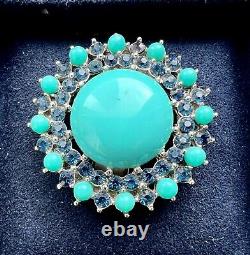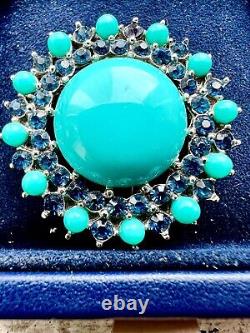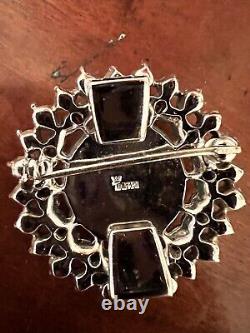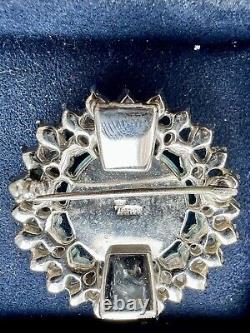Vintage Signed Trifari Crown Faux Turquoise Brooch





Alfred Philippe joined the team in 1930 and quickly become the head designer. The crown over the T was used in the later 1930's through the early 1970's. Since the 1920s Italian American designers Trifari produced some of the highest quality, exquisite jewellery designs. Popular in the 1930s with Hollywood producers and actors alike. Particularly famous for chief designer Alfred Philippe, till 1968, who, with previous experience with Van Cleef and Arpels, brought high craftsmanship and technique to the company. With pieces which can easily be mistaken for fine jewelry, it's easy to see why so many are held precious in collectors jewelry cabinets. The vintage designer Trifari is one of the most well-known and collectible designers. Trifari Jewellery designs are synonymous with quality. The designs are elegant and have a timeless quality about them that makes them perfect for today's fashions. Even their brushed gold-tone and silver-tone designs have something special about them. Gustavo Trifari, an Italian, learned the jewellery business from his grandfather.
In 1904, he immigrated to the USA to earn his fortune and start a new life. He partnered with his uncle, Ludovico Trifari to produce a company called Trifari and Trifari in 1910. Two years later, Gustavo left this business to start his own business which specialized in accessories. In 1918, he partnered with Leo F.
Krussman and founded the Trifari and Kussman Company. Krussman was the marketing man and Gustavo was the designer.
The next step in the Trifari partnership came in 1925, when the two men combined resources with Carl Fishel to form Trifari, Krussman and Fishel. The jewellery marketed by this company used the mark KTF with a taller T than the other letters.
There was also a line stamped KTF with a crown over the T made in 1954, but it is not as valuable as the earlier KTF pieces. These early KTF pieces are very rare and hard to find. Between 1930 and 1968 Alfred Philippe was the top designer for Trifari jewellery.
He had formerly been a designer for Van Cleefs and Arpel, so he came with a rich designing history behind him. Beware - many online sellers label any early Trifari designs as Alfred Philippe designs, when this is not the case. Some of his early designs are marked Trifari Pat. Pending and a patent search will give the design specifications. Trifari introduced a very successful line which they called "Jewels by Trifari" in 1938. A few years later, metals became scarce for manufacturing jewellery, due to the war, so Trifari used Sterling silver for many designs during this time. A few years later, in the 1940s, they patented a plating process called Trifanium. This plating method made the material look like real gold or silver and helped to maintain the condition of the metal over time. Trifari pieces are extremely well made and continue to stay in wonderful condition generations later. One of the most well-known and collectible of the Trifari pieces are the Lucite Jelly Belly pins.Once again, many jewellery sellers' market a wide variety of jewellery as jelly belly, but true Jelly Bellies have DuPont Lucite clear acrylic bellies. These pieces are figural, such as birds and fish and are very rare and highly valued. Trifari continued manufacturing during the 1950s and 1960s.
After this, it traded under the names a variety of companies. In 1975 and then again to Crystal Brands Jewellery Corporation in 1988.
